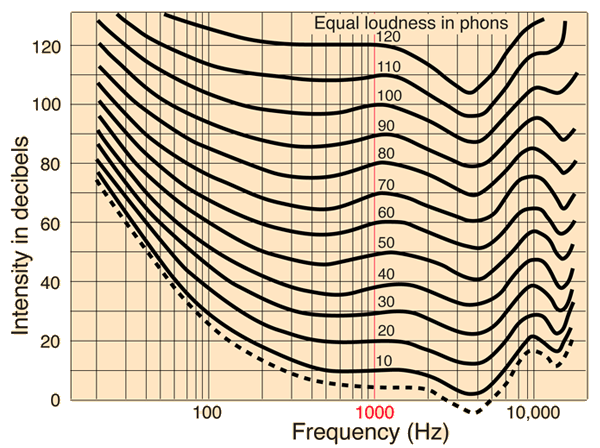Shockwave wrote: Speakers are remarkably insensitive to low pitches too. There are very, very few speakers that can output a C three octaves below the staff without a serious (extreme) reduction in volume. I have one designed to call wild elephants in Africa that reaches down to 14Hz, and tones that low are quite noticeable. Most speakers, particularly bass reflex, can show a lot of cone motion when they are making no sound at all.
I'm very skeptical that a human being can hear a musical tone at 14 Hz. Perhaps a pressure wave can be sensed or some harmonic content deduced, but a musical tone?
A pedal C may have no fundamental, but it has strong output at C below the staff and G at the bottom of the staff. Chances are those pitches are still below the rest of the ensemble and can easily come through with little competition. The double bass doesnt need to be gigantic and produce a tremendous amount of bass because instruments are scaled like singers, not like model trains. People built double basses to sound like bass voices, and violins to sound like high sopranos.
Precisely--thank you for reiterating my point. Tubas are best heard from their harmonic--not their fundamental content.
Actually, full-scalle basses have been constructed (even recently). Berlioz was in love with the darned thing; the major problem being that it wasn't playable with any facility (note the levers):

The harmonic content will be there no matter what, but it is the sound that the bass singer supplies below the other singers that adds to the whole. Otherwise one could croak into a megaphone and do the same job.
...and it's the harmonics of that bass voice that make him noticeable, not its weak fundamental.
I understand your reasoning, but in practice it works out almost the opposite. Higher frequencies are absorbed by the air, people, purses, seats, curtains, hairdos, coats, carpet and everything else in that hall more than low frequencies. High frequency waves are also short and tend to scatter off of objects in the hall while 20 or 30 foot bass waves reflect intact. The sum of all this is that bass carries in the concert hall, or even outdoors, better than treble.
While high firequencies are indeed attenuated more by porous surfaces than low, go back and take a look at the loudness curves I posted earlier. Note that they're extremely non-linear at the low end--that the low frequencies have to be boosted as the overall midrange volume gets quieter. That's why there are "loudness" controls on stereo equipment in attempt to compensate for the nonlinearity of the Fletcher-Munson curve.
Consider the implication that if the level of bass is perfect to the conductor's ears, it's going to be downright tinny at the back of the hall, where the volume is much lower.
Or, as anyone listening to a marching band from the top row of the bleachers can attest--"what sousaphones?".
This is a matter of human physiology--as sounds get softer, the bass goes away.
If you blow a tuba that hard it doesn't increase the bass, it just produces an obnoxious blat. That's what bass trombones are for.
I said nothing about blowing a tuba to distortion. What I did say was that harmonic content was perhaps more important than fundamental. This can be achieved with a change in mouthpiece or construction of the instrument.
The ear does not infer the existence of fundamental from harmonics. If there isnt any, you won't hear any. The ear more closely responds to the repetition rate of a wave, and that has nothing to do with whether there is fundamental or not.
I beg to differ and offer a concrete example Organ builders have been building instruments with "resultant" stops for centuries, being fully aware of this effect. Many organs with stops marked as 32' really create the effect by combining a 16' voice and 10 2/3' quint. Here's an example at random:
http://www.acbr.com/central/organ.htm
FWIW, there is a fairly lengthy list of instruments with 64' stops, but only two instruments with genuine 64' ranks.
Does anyone suppose that the tuba player honking out his pedal C is producing a fundamental tone at an audible level? Yet the ear perceives a note lower than the C an octave above. From what?
The ear is a very strange thing.





